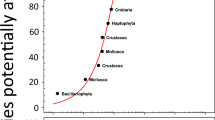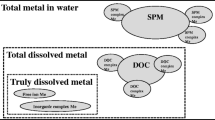Abstract
Purpose
Aluminum (Al) is an abundant, non-essential element with complex geochemistry and aquatic toxicity. Considering its complex environmental behavior is critical for providing a reasonable estimate of its potential freshwater aquatic ecotoxicity in the context of Life Cycle Impact Assessment (LCIA).
Methods
Al characterization factors (CFs) are calculated using the following: (1) USEtox™ model version 2.1 for environmental fate, (2) MINEQL+ to estimate the distribution of Al between the solid phase precipitate and total dissolved Al, (3) WHAM 7 for Al speciation within the total dissolved phase, and (4) Biotic Ligand Model (BLM) and Free Ion Activity Model (FIAM) for ecotoxicity estimation for seven freshwater archetypes and default landscape properties for the European continent. The sensitivity of the CFs to aquatic chemistry parameters is calculated. New CFs are compared with Dong et al. (Chemosphere 112:26–33, 2014) and default CF calculated by USEtox 2.1.
Results and discussion
Al CFs vary over 5 orders of magnitude between the seven archetypes, with an arithmetic average CFave of 0.04 eq 1,4-DCB (recommended for use), geometric mean CFgeo of 0.0014 eq 1,4-DCB, and weighted average CFwt of 0.026 eq 1,4-DCB. These values are lower (less toxic) than those for Cu, Ni, Zn, and Pb (with one exception). The effect factor (EF) contributed most to this variability followed by the bioavailability factor (BF), varying over 8 and 4 orders of magnitude, respectively. These revised CFs are 2–6 orders of magnitude lower than those presented by Dong et al. (Chemosphere 112:26–33, 2014) mainly because of consideration of Al precipitation.
Conclusions
Freshwater archetype-specific Al CFs for freshwater ecotoxicity that address the effect of Al speciation on bioavailability (BF) and ecotoxicity (EF) have been calculated, and a CF of 0.04 eq 1,4-DCB is recommended for use in generic LCA. For site-specific LCA, the choice of water chemistry and, in particular, pH, and consideration of metal precipitation could significantly influence results.
Practical implications
Incorporating estimates of metal speciation and its effect on aquatic toxicity is essential when conducting LCIA. Along with metal speciation estimates, the values derived from the definition of water chemistry parameters must also be included into LCIA. For site-generic assessments, we recommend using the arithmetic average of metal CFs. We also recommend using FIAM as a suitable alternative to BLM to estimate EF if the latter is not available. Consideration of metal speciation is essential for providing more realistic estimates of Al freshwater ecotoxicity in the context of LCIA.





Similar content being viewed by others
References
Bowen HJM (1966) Trace elements in biochemistry. Academic Press, London, p 241
Burton TM, Allan JW (1986) Influence of pH, aluminium and organic matter on stream invertebrates. Can J Fish Aquat Sci 43:1285–1289
Campbell PGC (1995) Interactions between trace metals and aquatic organisms: a critique of the free-ion activity model. In: Tessier A, Turner DR (eds) Metal speciation and bioavailability in aquatic systems, vol 1. John Wiley, New York, pp 45–102
Cullen JM, Allwood JM (2013) Mapping the global flow of aluminum: from liquid aluminum to end-use goods. Environ Sci Technol 47:3057–3064
Di Toro D, Allen H, Bergman H, Meyer J, Paquin P (2001) Biotic Ligand Model of the acute toxicity of metals: 1. Technical basis. Environ Toxicol Chem 20:2383–2396
Diamond ML, Mackay D, Cornett RJ, Chant L (1990) A model of the exchange of inorganic chemicals between water and sediments. Environ Sci Technol 24:713–722
Diamond M, Gandhi N, Adams W, Atherton J, Bhavsar S, Bullé C, Campbell P, Dubreuil A, Fairbrother A, Farley K, Green A, Guinée J, Hauschild M, Huijbregts M, Humbert S, Jensen K, Jolliet O, Margni M, McGeer J, Peijnenburg W, Rosenbaum R, van de Meent D, Vijver M (2010) The Clearwater consensus: the estimation of metal hazard in fresh water. Int J Life Cycle Assess 15:143–147
Dong Y, Gandhi N, Hauschild MZ (2014) Development of comparative toxicity potentials of 14 cationic metals in freshwater. Chemosphere 112:26–33
Driscoll CT, Schecher WD (1990) The chemistry of aluminum in the environment. Environ Geochem Health 12:28–49
Forbes VE, Calow P (2002) Applying weight-of-evidence in retrospective ecological risk assessment when quantitative data are limited. Human Ecol Risk Assess 8:1625–1639
Gandhi N, Diamond ML, van de Meent D, Huijbregts MAJ, Peijnenburg WJGM, Guinée J (2010) New method for calculating comparative toxicity potential of cationic metals in freshwater: application to copper, nickel, and zinc. Environ Sci Technol 44:5195–5201
Gandhi N, Huijbregts MAJ, van de Meent D, Peijnenburg WJGM, Guinée J, Diamond ML (2011a) Implications of geographic variability on ecotoxicity potentials of Cu, Ni and Zn in freshwaters of Canadian ecoregions. Chemosphere 82:268–277
Gandhi N, Diamond ML, Huijbregts MAJ, Guinée J, Peijnenburg WJGM, van de Meent D (2011b) The improvement in freshwater ecotoxicity methods for metals: examination of case studies to show implications of varying ambient chemistry. Int J Life Cycle Assess 16:774–787
Gandhi N, Huijbregts MAJ, van de Meent D, Peijnenburg WJGM, Guinée J, Diamond ML (2011c) Revised method of hazard and ecological risk assessments for calculating Comparative Toxicity Potentials of metals for which BLMs are not available. SETAC Europe, Milan, May 2011. Poster presentation
Gensemer RW (1991) The effects of pH and aluminum on the growth of the acidophilic diatom Asterionella ralfsii var. americana. Limnol Oceanogr 36:123–131
Gensemer RW, Playle RC (1999) The bioavailability and toxicity of aluminum in aquatic environments. Crit Rev Environ Sci Technol 29:315–450
Hauschild MZ, Huijbregts M, Jolliet O, Macleod M, Margni M, van de Meent D, Rosenbaum RK, McKone TE (2008) Building a model based on scientific consensus for Life Cycle Impact Assessment of chemicals: the search for harmony and parsimony. Environ Sci Technol 42:7032–7037
Hem JD (1986) Geochemistry and aqueous chemistry of aluminium. Kidney Int 18:S3–S7
Huijbregts MAJ, Thissen U, Guinée J, Jager T, Kalf D, van de Meent D, Ragas AMJ, Sleeswijk AW, Reijnders L (2000) Priority assessment of toxic substances in life cycle assessment. Part I: Calculation of toxicity potentials for 181 substances with the nested multi-media fate, exposure and effects model USES-LCA. Chemosphere 41:541–573
IAI (2015) Global Mass Flow Model. http://www.world-aluminium.org/publications/tagged/mass%20flow%20model/. Accessed 13 October 2015
Parent L, Campbell PGC (1994) Aluminum bioavailability to the green alga Chlorella pyrenoidosa in acidified synthetic soft water. Environ Toxicol Chem 13:587–598
Payet J, Jolliet O (2002) Comparative assessment of the toxic impact of metals on aquatic ecosystems: the AMI method. International Workshop on Life-Cycle Assessment and Metals, pp 188–191
Rosenbaum RK, Bachmann TM, Swirsky Gold L, Huijbregts MAJ, Jolliet O, Juraske R, Koehler A, Larsen HF, MacLeod M, Margni M, McKone TE, Payet J, Schuhmacher M, van de Meent D, Hauschild MZ (2008) USEtox—the UNEP/SETAC toxicity model: recommended characterisation factors for human toxicity and freshwater ecotoxicity in life cycle impact assessment. Int J Life Cycle Assess 13:532–546
Salazar J, Sowlati T (2008) Life cycle assessment of windows for the North American residential market: case study. Scand J For Res 23:121–132
Schecher WD, McAvoy DC (1998) MINEQL1—a chemical equilibrium modeling system, Ver 4.0. Environmental Research Software, Hallowell
Stumm W, Morgan JJ (1996) Aquatic chemistry. Wiley Interscience, New York
Tipping E (1998) Humic ion-binding model VI: an improved description of the interactions of protons and metal ions with humic substances. Aquat Geochem 4:3–48
Tipping E, Lofts S, Sonke JE (2011) Humic ion-binding model VII: a revised parameterisation of cation-binding by humic substances. Environ Chem 8:225–235
Acknowledgements
We thank Bob Santore (HydroQual Inc.) and his group for sharing BLM parameters and chronic ecotoxicity test data for Al exposure to aquatic organisms. We also thank Eirik Nordheim (EAA), and Chris Bayliss and Pernelle Nunez (International Aluminium Institute) for support throughout the project, and for facilitating data for model calculations. Bill Adams (Rio Tinto) provided the FOREGS stream water monitoring data for EU.
Funding
We acknowledge the funding from International Aluminium Institute (IAI) for this project.
Author information
Authors and Affiliations
Corresponding author
Additional information
Responsible editor: Ralph K. Rosenbaum
Electronic supplementary material
ESM 1
(DOCX 930 kb)
Rights and permissions
About this article
Cite this article
Gandhi, N., Diamond, M.L. Freshwater ecotoxicity characterization factors for aluminum. Int J Life Cycle Assess 23, 2137–2149 (2018). https://doi.org/10.1007/s11367-018-1451-y
Received:
Accepted:
Published:
Issue Date:
DOI: https://doi.org/10.1007/s11367-018-1451-y




